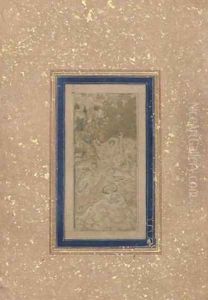Miskin Paintings
Miskin was an influential Indian painter during the time of the Mughal Empire, which was known for its significant contributions to art, architecture, and culture in South Asia. Born around 1540, Miskin worked in the imperial workshop of the Mughal court, a place that attracted a multitude of artists and craftsmen from across the region, fostering a unique blend of Persian, Indian, and various local styles that would define the Mughal artistic aesthetic.
Miskin's contributions to Mughal art were substantial, particularly in the realm of miniature painting, a form highly regarded and patronized by the Mughal emperors. He was one of the chief artists during the reign of Emperor Akbar, who ruled from 1556 to 1605 and was known for his support of the arts as well as his efforts to create a syncretic culture that combined elements of the diverse religions, cultures, and traditions within his empire. Miskin's work is characterized by its intricate detail, vibrant colors, and dynamic compositions, which often depicted scenes from court life, stories from Indian and Persian literature, and religious themes.
One of Miskin's most celebrated achievements was his participation in the illustration of the Akbarnama, the official chronicle of Emperor Akbar's reign, composed by the court historian Abul Fazl. This monumental work, which took several years and numerous artists to complete, is one of the most important sources of Mughal history as well as a masterpiece of Mughal art. Miskin's contributions to the Akbarnama and other imperial manuscripts helped solidify his reputation as a master painter.
After Emperor Akbar's death, Miskin continued to work in the Mughal court under Akbar's successors, though the details of his career during this period are less well documented. He is believed to have died around 1606. Despite the scarcity of personal details about his life, Miskin's legacy lives on through his surviving works, which continue to be celebrated for their beauty and historical value. His influence is evident in the development of Mughal painting, and he remains a significant figure in the history of South Asian art.
